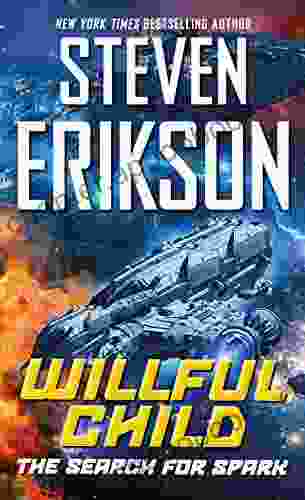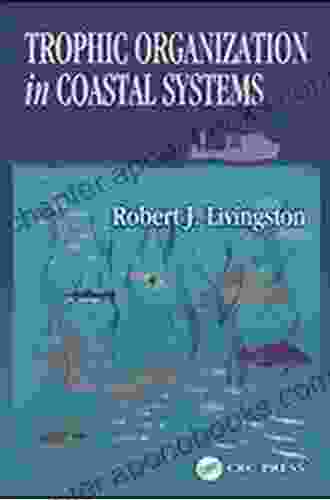Unveiling the Intricate Tapestry of Trophic Organization in Coastal Systems

Coastal systems, teeming with life and ecological complexity, serve as vibrant hubs of marine biodiversity. Understanding the intricate web of interactions among organisms within these ecosystems is not only captivating but also vital for ensuring their health and resilience. 'Trophic Organization In Coastal Systems' unravels the fascinating tapestry of trophic relationships, providing a profound comprehension of the energy flow that underpins these vital ecosystems.
4.4 out of 5
| Language | : | English |
| File size | : | 20935 KB |
| Screen Reader | : | Supported |
| Print length | : | 408 pages |
| Paperback | : | 325 pages |
| Item Weight | : | 12.5 ounces |
| Dimensions | : | 5 x 0.82 x 8 inches |
Delving into Trophic Levels
Trophic organization is the hierarchical arrangement of organisms within an ecosystem based on their feeding strategies. In coastal systems, this organization manifests as a cascade of trophic levels:
- Primary Producers: Organisms, such as phytoplankton and seagrass, that harness sunlight through photosynthesis to produce organic matter.
- Primary Consumers: Herbivores that directly consume primary producers. Common examples include small fish, zooplankton, and sea urchins.
- Secondary Consumers: Carnivores that prey on primary consumers, such as larger fish, marine mammals, and seabirds.
- Tertiary Consumers: Apex predators that occupy the top of the food web, consuming secondary consumers. Examples include sharks, killer whales, and large sea turtles.
- Decomposers: Organisms, like bacteria and fungi, that break down dead organic matter, releasing nutrients back into the ecosystem.
Unraveling Energy Flow
The flow of energy through trophic levels forms the backbone of coastal ecosystems. Primary producers convert sunlight into chemical energy, which is then transferred to primary consumers. As energy ascends the trophic cascade, there is a gradual loss due to metabolic processes and heat dissipation. This energy loss limits the length of food chains, typically restricting them to three or four trophic levels in coastal systems.
Food Webs and Keystone Species
Trophic organization is not linear but rather an intricate web of interconnected food chains. Organisms may occupy multiple trophic levels, depending on resource availability and life stage. Food webs depict these complex relationships, revealing the interdependence of species within coastal ecosystems.
Within these food webs, keystone species play a disproportionately large role in maintaining ecosystem balance. Removing or depleting a keystone species can trigger a cascading effect, disrupting the entire ecosystem. Sea otters, for instance, are keystone species that prey on sea urchins, preventing urchin populations from overgrazing kelp forests, which provide shelter and food for numerous other organisms.
Influence of Physical Factors
The structure and dynamics of trophic organization in coastal systems are significantly influenced by physical factors such as:
- Temperature: Warmer temperatures can accelerate metabolic rates, altering energy flow and species interactions.
- Salinity: Variations in salinity can affect organism distribution and physiological processes, shaping trophic relationships.
- Hydrodynamics: Currents and wave action can transport nutrients and organisms, influencing feeding patterns and food availability.
- Habitat Complexity: The availability and structure of habitats, such as mangroves, coral reefs, and seagrass beds, provide diverse niches for organisms, impacting trophic interactions.
Disturbances and Trophic Cascades
Coastal systems are inherently dynamic environments, subject to natural disturbances such as storms, floods, and temperature fluctuations. These disturbances can have profound impacts on trophic organization:
- Short-term Impacts: Disturbances can disrupt energy flow, alter species abundance, and trigger shifts in trophic interactions.
- Long-term Impacts: Severe disturbances can lead to trophic cascades, where changes in one trophic level have ripple effects throughout the entire food web.
Conservation and Management
Understanding trophic organization is crucial for effective conservation and management of coastal ecosystems. Ecosystems with diverse and balanced trophic structures tend to be more resilient and productive. Conservation efforts should aim to:
- Preserve keystone species and their habitats.
- Minimize human impacts on nutrient cycles and energy flow.
- Educate the public about the importance of trophic organization.
'Trophic Organization In Coastal Systems' offers a comprehensive exploration of the intricate web of interactions that sustains the lifeblood of our coastal ecosystems. By comprehending the hierarchical levels, energy flow, food webs, and the influence of physical factors, we gain invaluable insights into the delicate balance that governs these vital habitats. Embracing this knowledge equips us to make informed decisions that safeguard the health and resilience of coastal systems for generations to come.
4.4 out of 5
| Language | : | English |
| File size | : | 20935 KB |
| Screen Reader | : | Supported |
| Print length | : | 408 pages |
| Paperback | : | 325 pages |
| Item Weight | : | 12.5 ounces |
| Dimensions | : | 5 x 0.82 x 8 inches |
Do you want to contribute by writing guest posts on this blog?
Please contact us and send us a resume of previous articles that you have written.
 Book
Book Novel
Novel Page
Page Chapter
Chapter Text
Text Story
Story Genre
Genre Reader
Reader Library
Library Paperback
Paperback E-book
E-book Magazine
Magazine Newspaper
Newspaper Paragraph
Paragraph Sentence
Sentence Bookmark
Bookmark Shelf
Shelf Glossary
Glossary Bibliography
Bibliography Foreword
Foreword Preface
Preface Synopsis
Synopsis Annotation
Annotation Footnote
Footnote Manuscript
Manuscript Scroll
Scroll Codex
Codex Tome
Tome Bestseller
Bestseller Classics
Classics Library card
Library card Narrative
Narrative Biography
Biography Autobiography
Autobiography Memoir
Memoir Reference
Reference Encyclopedia
Encyclopedia Steven H Schwartz
Steven H Schwartz Lev Nikolayevich Tolstoy
Lev Nikolayevich Tolstoy Ron Haskins
Ron Haskins Robert Paul Wolff
Robert Paul Wolff Yvonne Markus
Yvonne Markus Lee Giles
Lee Giles Magnus Tessing Schneider
Magnus Tessing Schneider Leny Mendoza Strobel
Leny Mendoza Strobel Lois J Zachary
Lois J Zachary Nick Allen
Nick Allen Lichelle Slater
Lichelle Slater Leith Morton
Leith Morton Marc Hoffman
Marc Hoffman Park Honan
Park Honan M K Gooroochurn
M K Gooroochurn S S Van Dine
S S Van Dine Shane Harris
Shane Harris Lawrence Durrell
Lawrence Durrell Thomas Taylor
Thomas Taylor Vigdis Hjorth
Vigdis Hjorth
Light bulbAdvertise smarter! Our strategic ad space ensures maximum exposure. Reserve your spot today!

 Ivan TurnerFor Autoharp, Ukulele, Mandolin, Banjo, and Keyboard: Your Gateway to Musical...
Ivan TurnerFor Autoharp, Ukulele, Mandolin, Banjo, and Keyboard: Your Gateway to Musical...
 Kendall WardTSRA Review of Cardiothoracic Surgery: A Comprehensive Guide for Surgeons and...
Kendall WardTSRA Review of Cardiothoracic Surgery: A Comprehensive Guide for Surgeons and...
 Manuel ButlerThe Willful Child: Unlocking the Creativity and Confidence Within Every Child
Manuel ButlerThe Willful Child: Unlocking the Creativity and Confidence Within Every Child Steve CarterFollow ·3.3k
Steve CarterFollow ·3.3k Quentin PowellFollow ·10.6k
Quentin PowellFollow ·10.6k Caleb LongFollow ·18.9k
Caleb LongFollow ·18.9k Henry GreenFollow ·6.1k
Henry GreenFollow ·6.1k James GrayFollow ·8k
James GrayFollow ·8k Federico García LorcaFollow ·17.1k
Federico García LorcaFollow ·17.1k Owen SimmonsFollow ·6.8k
Owen SimmonsFollow ·6.8k Kenzaburō ŌeFollow ·18.9k
Kenzaburō ŌeFollow ·18.9k

 W.H. Auden
W.H. AudenTerrorist Events Worldwide 2024: A Comprehensive Guide to...
Terrorism is a global threat that affects...

 Carson Blair
Carson BlairBeautifully Uplifting And Enchanting Novel Set In The...
Set in the beautiful West Country, this...

 Jeffrey Cox
Jeffrey CoxAn Utterly Captivating and Uplifting Story of One Woman's...
Immerse yourself in an extraordinary...

 Greg Foster
Greg FosterEngaging the Issues Through the Politics of Compassion
: The Power of...
4.4 out of 5
| Language | : | English |
| File size | : | 20935 KB |
| Screen Reader | : | Supported |
| Print length | : | 408 pages |
| Paperback | : | 325 pages |
| Item Weight | : | 12.5 ounces |
| Dimensions | : | 5 x 0.82 x 8 inches |










